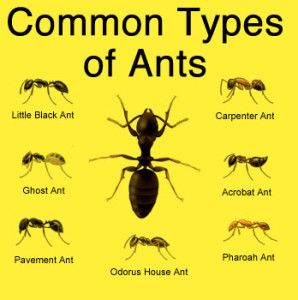Ants are a social insect that lives in colonies. Treatment plans should include killing the entire colony. Just spraying an ant with a typical ant spray, particularly a repellent spray will only kill a few at best.
Ants may enter your house foraging for food or seek shelter. Understanding the behavior of ants will help you with the recommended pest control procedures outlined here. They enter through the smallest openings, foraging for water or food. They are in search of either sweet based food or protein/grease based foods. Once they find a food source, ants will leave a pheromone trail for other ants to follow.
The most important ants in the United States are Argentine Ants, Carpenter Ants, Crazy Ants, Fire Ants, Ghost Ants, Leafcutter Ants, Odorous House Ants, Pavement Ants and Pharoah Ants. Understanding their behavior patterns will help you achieve the best ant control. When in doubt of which type of ant you have, give us a call.
Ant Control Tips and Strategies
There are two main types of ant problems that are commonly encountered with an ant problem. 
- Ants that live outside and forage inside
- Ants that already have a nest built inside
Your ant control strategy should depend on the type of infestation and the type of ant that is responsible. Identifying which type of ant you have is helpful, but may be difficult without a magnifying glass. It is also helpful to use a magnifying glass to inspect ant trails and nests.
1. Ants That Live Outside and Forage in the Home
Ants that live outside will travel inside your home to search for food. Some species ultimately reside and nest inside houses. Follow these steps to help prevent either type of infestation:
Step 1. Caulk and seal cracks and crevices to eliminate passages into the home. Since Ants are extremely industrious in finding entry points, you may not be able to seal them all.
Step 2. Clean around entry points with a detergent to remove the chemical trail pheromone, then spray a non-repellent residual insecticide such as Taurus SC or FUSE Insecticide around the perimeter and entry points.
Step 3. Refer to Ant Control Outside for more in-depth information.
2. Ants That Live (Nest) Inside Your Home
- Some ants don’t just enter your home foraging for food. Some ants will establish a colony inside.
- Indoor colonization occurs year-round, especially in warmer climates. Ant species that live in homes include Argentine Ants, Crazy Ants, Odorous House Ants, Pavement Ants, Pharaoh Ants, Thief Ants, and Carpenter Ants. All of these ants may infest food products.
- Ant Baits are a very successful method of controlling ants. They are safe to use around pets and children when you follow directions. Ant baits come in gels, granules, or stations. The active ingredients in these baits may be sugar-based or protein/grease-based, to lure a variety of ant species and target their dietary needs.
3. Special Considerations for Carpenter Ants
Carpenter Ants are most active in the evening hours when foraging for food, both inside the house and outside. By observing Ants at night, you may be able to tell where to spray or bait. Treating the nest itself is the last resort for Carpenter Ant control. Unless the entire nest is effectively treated, the colony may simply scatter. Use a non-repellent insecticide to minimize this risk.
The Best Way to Treat Carpenter Ants Inside the House:
- Place recommended Carpenter Ant Baits on the Ant trails.
- Use a non-repellent insecticide aerosol such as Alpine Aerosol or Phantom Aerosol. Non-repellent aerosols are superior to repellent aerosols because the Ants do not detect them and can’t avoid them. A typical Ant spray will kill only a few Ants and scatter the rest.
- For more in depth information : Carpenter Ants
To Prevent Further Carpenter Ant Infestations:
- Trim all trees and bushes so branches do not touch the house.
- Correct moisture problems such as leaky roofs and plumbing.
- Paint and/or seal exposed wood construction before it becomes wet.
- Replace rotted, water-damaged, and previously Ant-infested wooden parts of the structure.
- Eliminate wood/soil contacts.
- Remove dead stumps on the property and store firewood off the ground and away from the structure.
